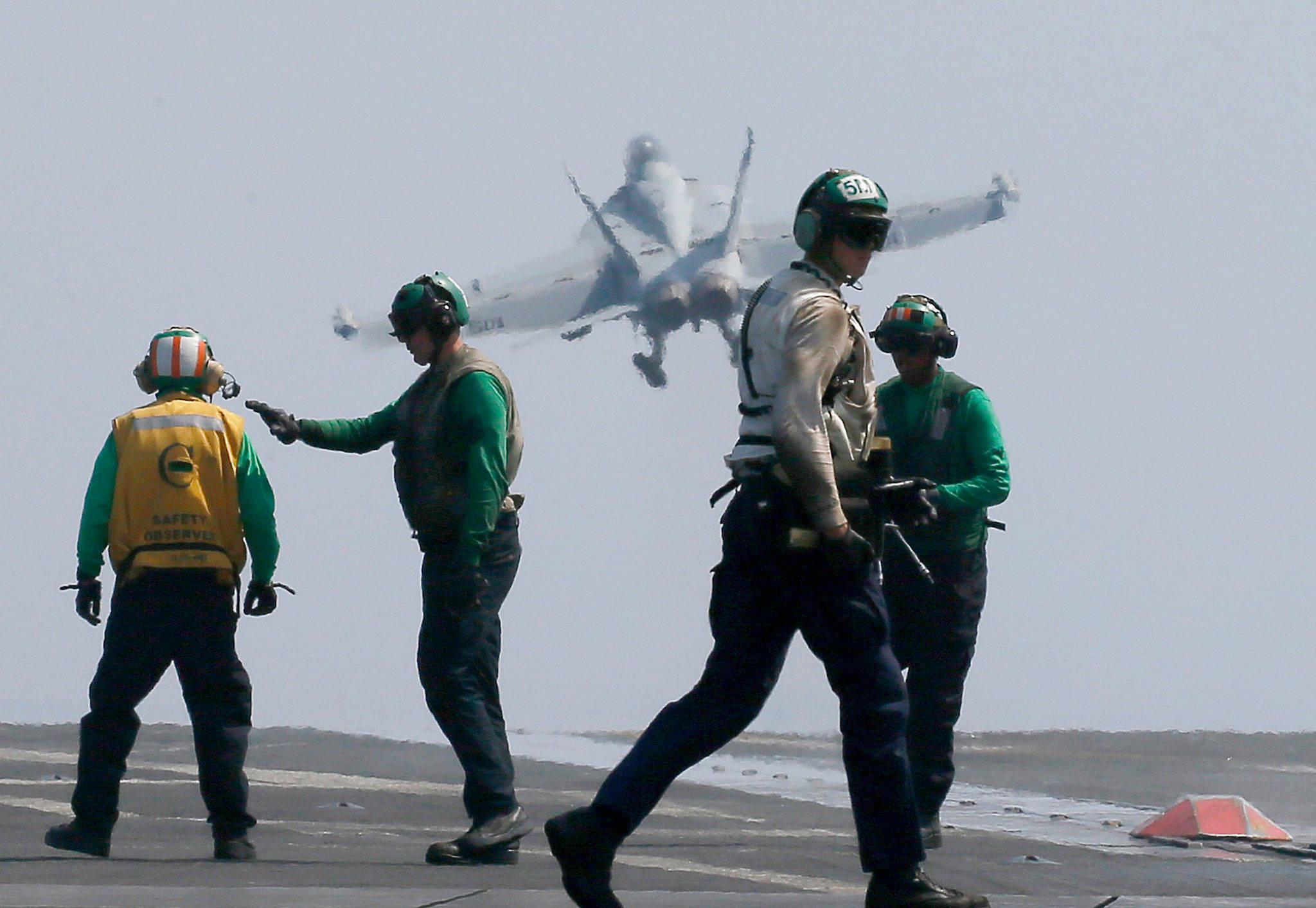By Roxana Tiron and Tony Capaccio / Bloomberg News
As President Donald Trump pushes for the Pentagon to buy more of Boeing’s F-18 aircraft, the U.S. Navy is grappling with an escalating problem: Pilots suffering potentially dangerous oxygen deprivation or a loss of cabin pressure in the fighter jets.
All F-18 models, including the Super Hornet that Trump has championed, have shown steady annual increases in what the Navy calls “physiological episodes,” according to service testimony obtained by Bloomberg News. What’s more, the data show that incidents of oxygen deprivation and cabin decompression have escalated in the last year, while service officials work to determine the root cause of the in-flight problems.
Trump’s promotion of the Super Hornet began in December, when the president-elect said in a Twitter posting, “Based on the tremendous cost and cost overruns of the Lockheed Martin F-35, I have asked Boeing to price-out a comparable F-18 Super Hornet!” Translating Trump’s request into action, Defense Secretary James Mattis commissioned a review of improvements that would “provide a competitive, cost effective, fighter aircraft alternative” to the F-35C, the Navy version of Lockheed Martin Corp.’s Joint Strike Fighter.
“Since May 1, 2010, all models” of the F-18 “show steady, yearly increases in the number of physiological episodes,” according to a staff memo prepared in advance of a hearing Tuesday of a House Armed Services subcommittee. Navy officials testifying before the committee called the problem the “No.1 safety issue.”
“I am concerned about this growing trend — one that has a significant effect on readiness and one that needs to be fixed,” Rep. Mike Turner, the Ohio Republican who leads the Tactical Air and Land Forces subcommittee, said in his opening statement.
Despite good-faith efforts, the “lack of overall progress” is “of great concern,” said Rep. Niki Tsongas, the panel’s top Democrat.
This isn’t the first time a high-performance U.S. military aircraft that flies at high altitudes has run into such episodes. In 2012, the Air Force had to track down a mystery after at least a dozen pilots flying Boeing’s F-22 Raptor fighters became dizzy and disoriented. The service eventually determined a valve that regulated oxygen flow into the Raptor pilot’s pressure vest was too weak to prevent the vest from inflating unnecessarily and restricting the pilot’s ability to breathe.
The newest versions of the F-18 — the Super Hornet and the Growler, which is tailored to jam an adversary’s electronics — “appear to have challenges in regards to hypoxia,” according to the memo on the problem written by staff members of House subcommittee. Hypoxia is a deficiency in the amount of oxygen reaching the body’s tissues.
Older versions of the plane, the A through D models, have problems with cabin pressure. Decompression sickness occurs due to cockpit depressurization at altitude and the resulting formation of nitrogen bubbles in the body’s venous system and other organs. The incidents point to the plane’s environmental control system.
The rate of reported occurrences of the physiological episodes per 100,000 flight hours almost doubled in the year ended Oct. 31 from the previous year on older F-18 models. They doubled on the newest Growlers and increased 11 percent for the newer Super Hornet.
That resulted in 45 instances for the Super Hornet versus 39 the previous year, according to Navy statistics obtained by Bloomberg. The trend continued in the three months since Nov. 1, with nine incidents reported by Jan. 31 during 28,600 hours of flying.
The Super Hornet and Growler issues “would appear to point to the onboard oxygen generating” system to which the Navy has made changes, the staff memo said.
“We are working closely with the Navy’s Physiological Episode Team to help identify root causes of physiological episodes and their solutions,” Caroline Hutcheson, a spokeswoman for Chicago-based Boeing, said in an email. “We take safety in flight very seriously and will continue to assist the Navy on the way forward.”
The Navy is conducting “fleet awareness” briefings for pilots and “has enhanced reduced-oxygen training so that pilots can more quickly determine when he or she is having symptoms of hypoxia,” according to the congressional staff memo, which said the service has installed chambers on two aircraft carriers to provide therapy “to pilots that have been exposed to decompression.”
“Moving forward, we will continue to fly while applying every resource to solve this challenging problem,” the top aviation officials for the Navy and Marine Corps said Tuesday in a prepared statement.
A 62-person “Physiological Episode Team” set up in May 2010 continues assess root causes and solutions, the service officials said.
Of the more than 380 episodes evaluated by the Navy team so far, 130 “have involved some form of contamination,” 114 involved an environmental control system component failure, 91 involved “human factors” and 50 concerned a component failure with the on-board oxygen generating system, the officials said.
An additional 13 involved a breathing-gas delivery component failure and 76 were inconclusive or involved another aircraft system not directly related to the breathing system, the officials said, with more than one cause found in a number of instances.
Talk to us
> Give us your news tips.
> Send us a letter to the editor.
> More Herald contact information.

























